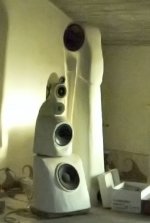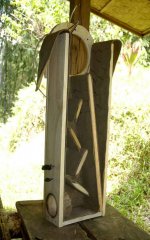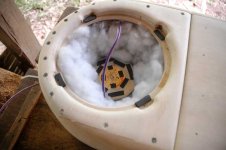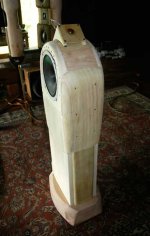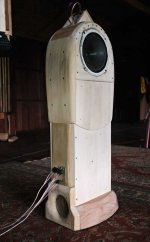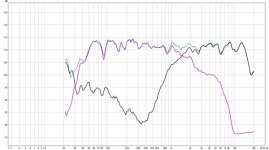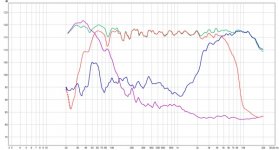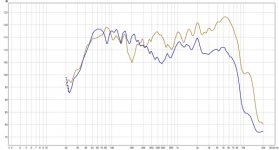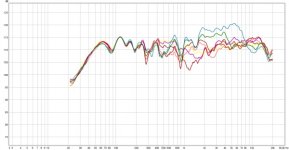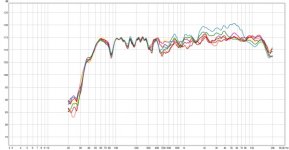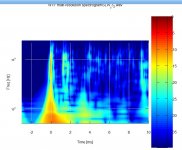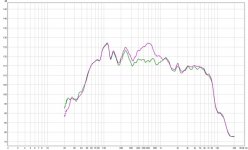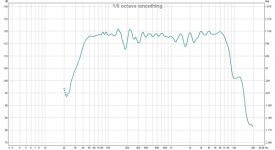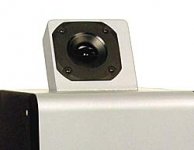CLS gave himself the answer . Since power/frequency contents in music is a degrading line -it depends also in which kind of music ,for example hip-hop produces a 40 % of prevailing bass - when highpassed sufficiently high the signal can be managed as a (HIGH) line level ,then mixed with resistors matching the impedances . This cannot be done with bass ,thus the dual VC.
CLS gave himself the answer . Since power/frequency contents in music is a degrading line -it depends also in which kind of music ,for example hip-hop produces a 40 % of prevailing bass - when highpassed sufficiently high the signal can be managed as a (HIGH) line level ,then mixed with resistors matching the impedances . This cannot be done with bass ,thus the dual VC.
I love the simplicity of this. Somehow I missed it in the thread earlier.
So after some thought, here are the assumptions I've made:
- Pretty much any components (higher order XO, notching, Zoebel), etc are all fair game after the stereo highpass caps tie to sum the signal.
- The smaller the caps, the more "protected" the stereo channels are from summing at a frequency that would impair stereo impression (3KHz highpass is a bad idea) or allow the amps to 'see' too much of each other
- The purpose of the resistors is to create 3dB reduction to offset summing--they can safely be omitted if a tweeter is used that happens to be 3db less efficient than the mids, or is double impedance.

I think it's answered above, but I need it this clearly: Is this safe for monoblock amplification or not?
-- Mark
Last edited:
Hi,
So you combined a single tweeter with what? Did you try stereolith style box?
- Elias
So you combined a single tweeter with what? Did you try stereolith style box?
- Elias
OK, I tried it. It works.
My tweeter is rated 8 Ohm, I use 2x 8.2 Ohm resistors for the Y connection. Since the real impedance of the tweeter is not flat, so I guess the voltage division is not entirely correct...
Nevertheless it works (and nothing blown). The tweeter is crossed very high (above 7~8kHz or so), I can not detect anything wrong by ears. Overall tonal balance seemed alright.
Other changes, like the physical arrangement of the driver... were also on going, re-EQ for sure, so no apple to apple comparison right now.
No, I didn't build a box like that. I just transformed my system into a big
W/M....(MT)...T...(TM)....M/W
The center T is mono (mentioned here), working with a 1st order HP, above 7kHz or so.
(MT) is 12" circular WG (Dayton) with 1" throat, about 2k~7kHz
M is 30" circular tractrix horn (Oris) with 7" cone driver, open back (without back chamber), about 240~2kH
W is 18" OB, under 240Hz
Mid-tweeters are spaced 1.3m; M and W are stacked vertically and spaced about 3m.
There's a sub, at the center on floor.
-------------
Back to the mono connected tweeter, the 2 resistors and the impedance of the driver form a voltage divider (and current sharing if one channel is muted). So their impedances can form different 'fading' curves between 2 channels. I'm not sure if it's the right term, I mean the proportion of each individual channel and their sum.
W/M....(MT)...T...(TM)....M/W
The center T is mono (mentioned here), working with a 1st order HP, above 7kHz or so.
(MT) is 12" circular WG (Dayton) with 1" throat, about 2k~7kHz
M is 30" circular tractrix horn (Oris) with 7" cone driver, open back (without back chamber), about 240~2kH
W is 18" OB, under 240Hz
Mid-tweeters are spaced 1.3m; M and W are stacked vertically and spaced about 3m.
There's a sub, at the center on floor.
-------------
Back to the mono connected tweeter, the 2 resistors and the impedance of the driver form a voltage divider (and current sharing if one channel is muted). So their impedances can form different 'fading' curves between 2 channels. I'm not sure if it's the right term, I mean the proportion of each individual channel and their sum.
Last edited:
Hello,
I have the idea to investigate the properties of the Stereolith layout since a comment from Graaf concerning my version of a laterally firing system.
For this I’ve done a little proto. It uses 2 supravox 215 RTF (that I have since 18 years !) and a TQWT box with a upward firing tweeter . Like this it’s possible to verify if the midbass has to be low passed high or low, and the TQWT will hopefully make some low range.
For the box design, I have used the fast approach of Voigt because the drivers need to be on the top of the line, one on each side. Then the Voigt simple formula says that if S=0 (the closed end of our TQWT), then the driver has to be in the middle (d = L/2). It’s perfect for my application, no more math required. And I did something of this kind years ago with two 10” for a sub (pic joined) , it was working well, so no hesitation.
Nothing special for the realization except that it’s all in timber cut with a chainsaw, so a lot of planer time to make it acceptable. I must add that it’s difficult to be more DIY as it’s a tree that I’ve cut myself…
Round edges where it’s useful, bracing, stuffing, all classic. I use a vent because, from experience, I hate the TQWT resonances.
Maybe it’s no more a TQWT then, but , NP, if it works.
I have the idea to investigate the properties of the Stereolith layout since a comment from Graaf concerning my version of a laterally firing system.

For this I’ve done a little proto. It uses 2 supravox 215 RTF (that I have since 18 years !) and a TQWT box with a upward firing tweeter . Like this it’s possible to verify if the midbass has to be low passed high or low, and the TQWT will hopefully make some low range.
For the box design, I have used the fast approach of Voigt because the drivers need to be on the top of the line, one on each side. Then the Voigt simple formula says that if S=0 (the closed end of our TQWT), then the driver has to be in the middle (d = L/2). It’s perfect for my application, no more math required. And I did something of this kind years ago with two 10” for a sub (pic joined) , it was working well, so no hesitation.
Nothing special for the realization except that it’s all in timber cut with a chainsaw, so a lot of planer time to make it acceptable. I must add that it’s difficult to be more DIY as it’s a tree that I’ve cut myself…
Round edges where it’s useful, bracing, stuffing, all classic. I use a vent because, from experience, I hate the TQWT resonances.
Maybe it’s no more a TQWT then, but , NP, if it works.
Attachments
Now, my problem is that I know very little about Stereolith secrets.
None of it’s owners took time to publicate a filter schematic.
I just know that it’s not a dipole, that the frontal width of the transducer has to be equal to the interaural distance (Schupbach claims that this reduces cross talk). He claims too that the ILD clues have little importance, then we can suppose that he crosses it’s tweeter as low as 1500. CLS experimentations with mono tweeter are successful too .
.
Some people say that stereolith uses and abuses of reflections, some swear that not. Hummm, all this is really terra incognita.
Electrically I will use my DCX as filter and EQ or even something else…It’s not the dark ages anymore, with this tool what took months decades ago can be done in one day with the tremendous possibility of making instant comparisons.
For measuring this, what to do ? from the listening axis or or from the own driver axis ? Already here we can say that if the driver axis rules, then this system uses reflections…
Shall see. First task, make it flat from the listening axis. My little TQWT is maybe not a total success : going around 50Hz without the port, but the only resonance of its own is a narrow peak at 100Hz. I prepare the sub in case of, and the tweeter is easy to fit at around 2000 Hz. Step Ok, but the cone breaking is easy to see.
Listening this first fast setting has been deceiving: it’s not Stereolith but Stereos**t.
The balance is really disastrous, but the worse is imaging : all on line, nothing on the sides. Really a ridiculous speaker sounding tiny.
Only one positive fact: there is enough bass to get rid of any subwoofer.
None of it’s owners took time to publicate a filter schematic.
I just know that it’s not a dipole, that the frontal width of the transducer has to be equal to the interaural distance (Schupbach claims that this reduces cross talk). He claims too that the ILD clues have little importance, then we can suppose that he crosses it’s tweeter as low as 1500. CLS experimentations with mono tweeter are successful too
Some people say that stereolith uses and abuses of reflections, some swear that not. Hummm, all this is really terra incognita.
Electrically I will use my DCX as filter and EQ or even something else…It’s not the dark ages anymore, with this tool what took months decades ago can be done in one day with the tremendous possibility of making instant comparisons.
For measuring this, what to do ? from the listening axis or or from the own driver axis ? Already here we can say that if the driver axis rules, then this system uses reflections…
Shall see. First task, make it flat from the listening axis. My little TQWT is maybe not a total success : going around 50Hz without the port, but the only resonance of its own is a narrow peak at 100Hz. I prepare the sub in case of, and the tweeter is easy to fit at around 2000 Hz. Step Ok, but the cone breaking is easy to see.
Listening this first fast setting has been deceiving: it’s not Stereolith but Stereos**t.

The balance is really disastrous, but the worse is imaging : all on line, nothing on the sides. Really a ridiculous speaker sounding tiny.
Only one positive fact: there is enough bass to get rid of any subwoofer.
I’ve been changing the tweeter for something (an open CD 1”) that will go down to 1500 Hz. Again easy to make it flat.
Result : still worse. Before it was on line but with comparatively a kind of depht. Now, the image is on the top of the cabinet . Difficult to make more pinpointed. And the balance…OMG ! To much problems at once.
Third iteration, a super tweeter (made from a cheap and fake CD driver, phenolic dome, very thin sound, little distors). This time I will cross higher like 5000 (image below).
Immediately the image gets "wider" and the balance less cardboard sound.
Fourth iteration (don’t forget that it only takes two mouse clicks), no more low pass on the dear Supravox and the tweeter takes at 10000 Hz.
Better again but we can speak of a “bright sound”. It’ easy now to recognize the reflections coming from the side walls (on sharp transients as always).
Only some records (binaural demos) show a beginning of widening. All the rest (as any Archiv record is still very narrowed), and it’s definitively not a big sound.
Here the two first filter versions
Result : still worse. Before it was on line but with comparatively a kind of depht. Now, the image is on the top of the cabinet . Difficult to make more pinpointed. And the balance…OMG ! To much problems at once.
Third iteration, a super tweeter (made from a cheap and fake CD driver, phenolic dome, very thin sound, little distors). This time I will cross higher like 5000 (image below).
Immediately the image gets "wider" and the balance less cardboard sound.
Fourth iteration (don’t forget that it only takes two mouse clicks), no more low pass on the dear Supravox and the tweeter takes at 10000 Hz.
Better again but we can speak of a “bright sound”. It’ easy now to recognize the reflections coming from the side walls (on sharp transients as always).
Only some records (binaural demos) show a beginning of widening. All the rest (as any Archiv record is still very narrowed), and it’s definitively not a big sound.
Here the two first filter versions
Attachments
Times come to investigate more deeply.
First job , walking aroung the speaker: I discovered that my head being just above the speaker, the image is wider and more populated. Of course, it’s the reflections. Nothing to do with this, but it’s a clue.
Then, from the listening point ( 2.50 meters at this time) I discovered the same effect when switching off the tweeter : dull but wide.
Just the tweeter was masking these (tiny) clues. Simple precedence effect. Strange anyway when I listen to the tweeter alone : 10000 hz with a resulting Bessel 24 slope, it’s not a lot af acoustic power, but it makes the localization.
Reducing the level can’t be a solution. So, I have to fight the precedence effect with it’s own weapons : retarding the tweeter. First attempt by ear only. Wow, it works !
When reading the value of the optimal delay (even with good eyes and a 800x600 resolution, the control screen is far away at 8 meters) I’ve been surprised : 19.36 ms ! omg my step !
Subjectivity problems may you think, or maybe I’m deaf.
Hummm, let’s see :
As I can’t stop when I’m on a good way, I discovered too that a delay between 0.15 and 0.90 ms on any supra was a great improvement in imaging and improvement of something else, a permanent resonance sameness, that I really dislike on these speakers (maybe the very deep cone? Maybe the boxy sound ?).
Last touch, one low shelving 6dB + 4dB @ 119 Hz and a high one -4 dB @ 706 Hz. The sound is not dull, relations between the high of the supra and the tweeter are not touched, but now it’s no more a tiny sound, and no boominess…
First job , walking aroung the speaker: I discovered that my head being just above the speaker, the image is wider and more populated. Of course, it’s the reflections. Nothing to do with this, but it’s a clue.
Then, from the listening point ( 2.50 meters at this time) I discovered the same effect when switching off the tweeter : dull but wide.
Just the tweeter was masking these (tiny) clues. Simple precedence effect. Strange anyway when I listen to the tweeter alone : 10000 hz with a resulting Bessel 24 slope, it’s not a lot af acoustic power, but it makes the localization.
Reducing the level can’t be a solution. So, I have to fight the precedence effect with it’s own weapons : retarding the tweeter. First attempt by ear only. Wow, it works !
When reading the value of the optimal delay (even with good eyes and a 800x600 resolution, the control screen is far away at 8 meters) I’ve been surprised : 19.36 ms ! omg my step !
Subjectivity problems may you think, or maybe I’m deaf.

Hummm, let’s see :
- The speaker is at 4m50 from the side wall, so the reflection has to cover 9 m till my ears.
- · The listening distance is 2m50
- · Then the difference is 9 – 2.50 = 6m50
- · Here, altitude and tropical zone, sound speed must be at 342m/s
- · Make the operation: 19 ms. Not so bad.

As I can’t stop when I’m on a good way, I discovered too that a delay between 0.15 and 0.90 ms on any supra was a great improvement in imaging and improvement of something else, a permanent resonance sameness, that I really dislike on these speakers (maybe the very deep cone? Maybe the boxy sound ?).
Last touch, one low shelving 6dB + 4dB @ 119 Hz and a high one -4 dB @ 706 Hz. The sound is not dull, relations between the high of the supra and the tweeter are not touched, but now it’s no more a tiny sound, and no boominess…
Last edited:
Before speaking like a reviewer, let’s see the resulting curves.
Well, I believed that after what I have seen with my other system (omni, OSD, LQ and variants..) I couldn’t see something worse…error.
Can be seen below, only the 2 supras running, from 2.50 m .
The front curve has a big notch just where the lateral one has a bump.
The lateral one is ascending (in despite of the -4dB shelving ) while the front one is descending.
Not very beautiful
Strangely, a correction of the big irregularities while keeping the general shape has been ruining the already poor imaging abilities.
.
Well, I believed that after what I have seen with my other system (omni, OSD, LQ and variants..) I couldn’t see something worse…error.
Can be seen below, only the 2 supras running, from 2.50 m .
The front curve has a big notch just where the lateral one has a bump.
The lateral one is ascending (in despite of the -4dB shelving ) while the front one is descending.
Not very beautiful

Strangely, a correction of the big irregularities while keeping the general shape has been ruining the already poor imaging abilities.
.
Attachments
Going back to the flat non delayed and non shelved settings is better to interpret the directivity plots. Here obtained by turning the speaker on itself by 15° steps. Ok, old style chart…
You can see too the evolution of the step , and the wavelets chart on listening axis that I was not expecting so clean. But it shows clearly the lack of energy in the middle.
- First, with a 150ms window, just a big bump +4 dB only on axis between 1800 and 10000. Supra beaming.
- With a shorter windows, the bump stays, but a dip centered on 1200 Hz appears from 30 to 45°.
- The influence of the tweeter disappears slowly off axis.
You can see too the evolution of the step , and the wavelets chart on listening axis that I was not expecting so clean. But it shows clearly the lack of energy in the middle.
Attachments
So this layout is not an omni radiator as I am used to play with.
We have lobing with an important null between 30° and 50°but this only between 1000 and 2000, and then a dissymetry in the HF : the tweeter sends its energy in the frontal plane, but the supras send their HF by the sides of the speaker. Logic after all.
The perception of any wide space needs obviously the lateral reflections, and the supra are generous here with the delayed setting subjectively approved that produces it’s own cancellations and reinforcements...
As a temporary conclusion, I am sure that the real stereolith is not working like that, not so much reflection dependent. How can they conciliate a single tweeter >> 1500 Hz and avoid that all the imaging could be pinpointed towards it?
Is it one of the explanation of the big default of the stereolith : only working on binaural records ???
We have lobing with an important null between 30° and 50°but this only between 1000 and 2000, and then a dissymetry in the HF : the tweeter sends its energy in the frontal plane, but the supras send their HF by the sides of the speaker. Logic after all.
The perception of any wide space needs obviously the lateral reflections, and the supra are generous here with the delayed setting subjectively approved that produces it’s own cancellations and reinforcements...
As a temporary conclusion, I am sure that the real stereolith is not working like that, not so much reflection dependent. How can they conciliate a single tweeter >> 1500 Hz and avoid that all the imaging could be pinpointed towards it?
Is it one of the explanation of the big default of the stereolith : only working on binaural records ???
Now the sound :
Impossible to have a tweeter taking low, no imaging.
Absolutely ugly without EQ on the Supra, and ridiculous without delays. My TV sounds better.
But everything changes with the delays and deserves the "very surprising" label. Have to say that it doesn’t work with the reverb settings of my sound card. Delay is not reverb…
· When listening, the first schock is that the speaker is very close, but the sound comes like 2 or 3 meters behind.
· Some informations can be identified as coming from the walls, but not very often (if not so it’s a big trouble). Mostly the virtual sources are between, in the no speaker/no wall zone, and they are stable. More, they are where they have to be. The classic succession of bass, cello, viola and violin is incremented 20 by 20°. Really very enjoyable. On many records, it fills the room with music, and sometimes I instinctively seach with the eyes the origin of the sound.
· One of my favourite tests is the Guilini’s Don Giovanni (1959) that I use since 30 years. There is a lot of natural effects, they are well restituted, especially the depht. I had a great time listening the Act III.
· It’s like this on any multi mixed record, classical or synthetic music. It’s not a dammned sameness, the personnality of each local is respected. IIRC, the real Stereolith is only great with binaural records, it’s a great limitation.
· Speaking of the voicing, it’s very sweet and relaxing. No harshness in the treble and the native personnality of the supra is destroyed by the EQ and the delays. Sounds like a good OB. But an OB with low range, it doesn’t needs a sub, except maybe on a few organ pieces. Absolutely no boominess, bass range is as well defined in tune than in localization. Voices, piano, drums…looks like there is no big problem now.
So perfect shot? No, and never this will be a great system. SPL is very limited, slam is soft. It’s impossible to feel the punch in the chest when the drums are hit or when the organ goes very low. Very fast, the supra reaches it’s limits.
Ok, the specs speak of 95 dB, but it’s including the peaks. Once removed by EQ, it’s a 85 dB boomer with a small gauge 25 mm coil. No miracle, it can’t play a real level symphony.
Better to see this as a night time speaker .
Comparing it to my other system is not very fair, this one is in development since 3 years and the stereolike since 4 days.
But it’s interesting : same room, same electronics. The OSD-LQ makes everything better, even if I use it’s subs with the stereolike. Much more details, much more ambient infos, much more involvement, much more emotion.
With the stereolike I am in front of the music, with the other one I am inside. And no SPL problem…removing the 20Hz boost, and fan speed on 3, it could become an astounding club machine.
That’s an other important factor of realistic reproduction.
Impossible to have a tweeter taking low, no imaging.
Absolutely ugly without EQ on the Supra, and ridiculous without delays. My TV sounds better.
But everything changes with the delays and deserves the "very surprising" label. Have to say that it doesn’t work with the reverb settings of my sound card. Delay is not reverb…
- · The listening distance is not very important, it works as well from 15 to 1 meter, but the best for me is 2.50m.
- · Looks like the thing doesn’t appreciate to be too close from the back wall. Here, I have 5 m, but 1 m is enough.
- · In the median line of a corner, it’s one more disaster, It has to be in the axis of the room and symmetric regarding the side walls.
- · The sweet spot is very wide, at 2.50m, at least 3 people could seat side to side. They can turn the head, nothing changes.
· When listening, the first schock is that the speaker is very close, but the sound comes like 2 or 3 meters behind.
· Some informations can be identified as coming from the walls, but not very often (if not so it’s a big trouble). Mostly the virtual sources are between, in the no speaker/no wall zone, and they are stable. More, they are where they have to be. The classic succession of bass, cello, viola and violin is incremented 20 by 20°. Really very enjoyable. On many records, it fills the room with music, and sometimes I instinctively seach with the eyes the origin of the sound.
· One of my favourite tests is the Guilini’s Don Giovanni (1959) that I use since 30 years. There is a lot of natural effects, they are well restituted, especially the depht. I had a great time listening the Act III.
· It’s like this on any multi mixed record, classical or synthetic music. It’s not a dammned sameness, the personnality of each local is respected. IIRC, the real Stereolith is only great with binaural records, it’s a great limitation.
· Speaking of the voicing, it’s very sweet and relaxing. No harshness in the treble and the native personnality of the supra is destroyed by the EQ and the delays. Sounds like a good OB. But an OB with low range, it doesn’t needs a sub, except maybe on a few organ pieces. Absolutely no boominess, bass range is as well defined in tune than in localization. Voices, piano, drums…looks like there is no big problem now.
So perfect shot? No, and never this will be a great system. SPL is very limited, slam is soft. It’s impossible to feel the punch in the chest when the drums are hit or when the organ goes very low. Very fast, the supra reaches it’s limits.
Ok, the specs speak of 95 dB, but it’s including the peaks. Once removed by EQ, it’s a 85 dB boomer with a small gauge 25 mm coil. No miracle, it can’t play a real level symphony.
Better to see this as a night time speaker .
Comparing it to my other system is not very fair, this one is in development since 3 years and the stereolike since 4 days.
But it’s interesting : same room, same electronics. The OSD-LQ makes everything better, even if I use it’s subs with the stereolike. Much more details, much more ambient infos, much more involvement, much more emotion.
With the stereolike I am in front of the music, with the other one I am inside. And no SPL problem…removing the 20Hz boost, and fan speed on 3, it could become an astounding club machine.
That’s an other important factor of realistic reproduction.

Attachments
As a conclusion, 5 things :
- With the very constestable help of some judicious delays, the stereolith lateral firing concept produces an exceptional imaging with only 3 speakers, on any record.
- It’s here really two wide range "unfiltered"
 and a super tweeter
and a super tweeter
- But the digital voicing comes at the price of the dynamic range, just ok for domestic use with these drivers.
- But it’s almost impossible to do it passive or analogic.
- The secret of Stereolith remains in the darkness.

A little update about the paradoxical utilization of the delays.
first plot from the left: listening axis, listening distance 2m50, 30 ms window (no difference with shorter ones)
purple is the 2 supra together without any EQ or other management
green is after application of 0.73ms (on any)
can see that the big hump is gone and the low range is unmodified
second plot : both drivers with delay, same distance and window but seen from the driver axis after equalisation.
third plot : all same but without the delay...no big perturbation
fourth plot : single driver, for sure np with any delay.
fifth plot : steps from the listening axis, both drivers, the undelayed one rings...this is maybe the most revealing observation.
As you see, these delays don't have only a psycho-acoustic dimension.
This reminds me a thread where the author was making a comparison between some utilization of the phase and the unsharp mask in digital imaging... , because the effect is much more than only dampening some undulations in the TQWT line.
, because the effect is much more than only dampening some undulations in the TQWT line.
Have to add that after some modifications, the lobing hole 45°/1200 Hz is gone. Definitively a very interesting formula to set up.
first plot from the left: listening axis, listening distance 2m50, 30 ms window (no difference with shorter ones)
purple is the 2 supra together without any EQ or other management
green is after application of 0.73ms (on any)
can see that the big hump is gone and the low range is unmodified
second plot : both drivers with delay, same distance and window but seen from the driver axis after equalisation.
third plot : all same but without the delay...no big perturbation
fourth plot : single driver, for sure np with any delay.
fifth plot : steps from the listening axis, both drivers, the undelayed one rings...this is maybe the most revealing observation.
As you see, these delays don't have only a psycho-acoustic dimension.
This reminds me a thread where the author was making a comparison between some utilization of the phase and the unsharp mask in digital imaging...
 , because the effect is much more than only dampening some undulations in the TQWT line.
, because the effect is much more than only dampening some undulations in the TQWT line.Have to add that after some modifications, the lobing hole 45°/1200 Hz is gone. Definitively a very interesting formula to set up.
Attachments
Radugazon, in an interview from 2002 Schupbach states that the side firing woofers are crossed over at 2800Hz.
"
AVguide: Why have not the tweeter in the center of the box set, exactly?
Schupbach: My new construction is even closer to the Hörphysiologie of man. We have the research that we have made in recent years to improve. Because the hearing is not symmetrical - a left-handed hears differently from a right-handed - the tweeter is not exactly the middle of the box mounted in. This realizes the nature of existing in interference between the two channels.
"
Does this mean tweeter is placed off center axis? And how much?
- Elias
AVguide: Why have not the tweeter in the center of the box set, exactly?
Schupbach: My new construction is even closer to the Hörphysiologie of man. We have the research that we have made in recent years to improve. Because the hearing is not symmetrical - a left-handed hears differently from a right-handed - the tweeter is not exactly the middle of the box mounted in. This realizes the nature of existing in interference between the two channels.
"
Does this mean tweeter is placed off center axis? And how much?
- Elias
Last edited:
Thx markus,
So tweeter takes at 2800...
I see that two times he uses the word "dipol", probably he means "stereo dipole", because this speaker can't be an acoustic dipole.
Anyway, he keeps the secret for himself, if secret there is.
@ Elias : indeed, we can see on the picture that the tweeter is not centered, I was missing it, my German sucks.
I never heard about a dominant brain hemisphere concerning audio neural system, must be a new discovery. In this case is there a product for rightists and a product for leftists ?
Will be easy to test on my speaker, but I have a doubt.
So tweeter takes at 2800...
I see that two times he uses the word "dipol", probably he means "stereo dipole", because this speaker can't be an acoustic dipole.
Anyway, he keeps the secret for himself, if secret there is.
@ Elias : indeed, we can see on the picture that the tweeter is not centered, I was missing it, my German sucks.
I never heard about a dominant brain hemisphere concerning audio neural system, must be a new discovery. In this case is there a product for rightists and a product for leftists ?
Will be easy to test on my speaker, but I have a doubt.
Attachments
Last edited:
As always, amazing!
19ms of delay on tweeter! That's equivalent to putting it back 6.5m further. I'm wondering how it'd behave when the tweeter is physically relocated. (I saw the tweeter is 'put' on the top of cabinet, so it's movable, right?) Maybe the reflections play an important role, too.
And the following:
Does it mean the delay on supravox is applied on only one side? Do you hear any shifting of images when the 2 drivers are in slightly different timing? Since their magnets are already touching each other, can't be visuallized as (physically) pushed 'backward' any further, but it seems they are virtually moved to the opposite side. No?
19ms of delay on tweeter! That's equivalent to putting it back 6.5m further. I'm wondering how it'd behave when the tweeter is physically relocated. (I saw the tweeter is 'put' on the top of cabinet, so it's movable, right?) Maybe the reflections play an important role, too.
And the following:
... I discovered too that a delay between 0.15 and 0.90 ms on any supra was a great improvement in imaging and improvement of something else...
Does it mean the delay on supravox is applied on only one side? Do you hear any shifting of images when the 2 drivers are in slightly different timing? Since their magnets are already touching each other, can't be visuallized as (physically) pushed 'backward' any further, but it seems they are virtually moved to the opposite side. No?
@ CLS...
troublesome delays...
It's the only solution to get imaging here. More or less, it's like the position "wide stereo" of any boombox. Well known effect too in the production studios and easy to emulate with a DCX, but it's not reverb or ping pong echoe.
The delay of the tweeter has to be 19 ms because if not so it arrives before the lateral signal of the reflected supravoxes that gives the notion of width.
It's very easy to ear the very positive difference. Now, the coherence of the signal is compromised in the median plane : no more synchronicity with the Hf of the main drivers, but OTOH the reflected sound is coherent. Have to choose what sounds the best and not what looks the best. Trade off as always but no mystery.
For the supravoxes, of course, the delay has to be on only one side, if not so, nothing happens. The plots up there show the cancellation that is a secondary effect but that I use instead of equalizing this bump.
Anyway, I dunno why this is mandatory for imaging.
Putting the delay on the right or on the left driver produces the same curve. But, when listening, I always "like" more the when the right side is retarded.
0.73 ms is too short for a real precedence effect, but with what Elias has seen on the German interview, I think of something : these famous asymmetries of perception R/L that justify the stereolith tweeter on the left side...
Could it be because the majority of right handed listeners are more weighted on the right side ? Then have to diminish this by a micro precedence effect that favorizes the left side ?
This issue is not noticeable in a classic stereo setting, but the stereolith is very delicate to setup and not so robust. Why not after all, we have already a dominant eye (right one for right handed ppl).
Hum, it's just a lot of "maybe"
I have a lot of docs about hearing physiology, have to read, this will remind me the good ole days.
troublesome delays...
It's the only solution to get imaging here. More or less, it's like the position "wide stereo" of any boombox. Well known effect too in the production studios and easy to emulate with a DCX, but it's not reverb or ping pong echoe.
The delay of the tweeter has to be 19 ms because if not so it arrives before the lateral signal of the reflected supravoxes that gives the notion of width.
It's very easy to ear the very positive difference. Now, the coherence of the signal is compromised in the median plane : no more synchronicity with the Hf of the main drivers, but OTOH the reflected sound is coherent. Have to choose what sounds the best and not what looks the best. Trade off as always but no mystery.
For the supravoxes, of course, the delay has to be on only one side, if not so, nothing happens. The plots up there show the cancellation that is a secondary effect but that I use instead of equalizing this bump.
Anyway, I dunno why this is mandatory for imaging.
Putting the delay on the right or on the left driver produces the same curve. But, when listening, I always "like" more the when the right side is retarded.
0.73 ms is too short for a real precedence effect, but with what Elias has seen on the German interview, I think of something : these famous asymmetries of perception R/L that justify the stereolith tweeter on the left side...
Could it be because the majority of right handed listeners are more weighted on the right side ? Then have to diminish this by a micro precedence effect that favorizes the left side ?
This issue is not noticeable in a classic stereo setting, but the stereolith is very delicate to setup and not so robust. Why not after all, we have already a dominant eye (right one for right handed ppl).
Hum, it's just a lot of "maybe"
I have a lot of docs about hearing physiology, have to read, this will remind me the good ole days.
More or less, it's like the position "wide stereo" of any boombox. Well known effect too in the production studios and easy to emulate with a DCX, but it's not reverb or ping pong echoe.
I think that it's rather less than more and that is exactly why it doesn't sound blurry nor phasey
I believe that there must be significant and decisive difference between "wide stereo" of boomboxes by means of phase shifting and "wide stereo" of his stereolith-like setup by means of global time delay
- Home
- Loudspeakers
- Multi-Way
- Stereolith Loudspeakers Question
